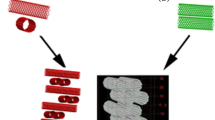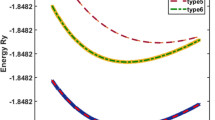Abstract
According to the principle of thermal activation process, the energy state of a material under the action of stress is a function of local stress. A generalized Butler-Volmer relationship for the electrode reaction on the surface of a curved electrode is derived, which takes account of the effects of local stress and the radius of mean curvature. From this relationship, the overpotential is found to be proportional to hydrostatic stress and the activation volume under the condition of open circuit. The conditions for the deposition of the material made solely from solute atoms and the formation of surface pits and porous structures are obtained, using the generalized Butler-Volmer relationship.
Similar content being viewed by others
References
L. Lu, X. Han, J. Li, J. Hua, and M. Ouyang, J. Power Sources 226, 272 (2013).
S. Goriparti, E. Miele, F. De Angelis, E. Di Fabrizio, R. Proietti Zaccaria, and C. Capiglia, J. Power Sources 257, 421 (2014).
H. D. Yoo, E. Markevich, G. Salitra, D. Sharon, and D. Aurbach, Mater. Today 17, 110 (2014).
X. Zhang, W. Shyy, and A. Marie Sastry, J. Electrochem. Soc. 154, A910 (2007).
Y. F. Gao, and M. Zhou, J. Appl. Phys. 109, 014310 (2011).
F. Yang, Mater. Sci. Eng. A 409, 153 (2005).
F. Q. Yang, Sci. China-Phys. Mech. Astron. 55, 955 (2012).
J. L. Zang, and Y. P. Zhao, Int. J. Eng. Sci. 61, 156 (2012).
I. Ryu, J. W. Choi, Y. Cui, and W. D. Nix, J. Mech. Phys. Solids 59, 1717 (2011).
K. Oldham, J. Myland, and A. Bond, Electrochemical Science and Technology: Fundamentals and Applications (John Wiley & Sons, New York, 2011).
J. A. V. Butler, Trans. Faraday Soc. 19, 729 (1924).
T. E. Gruz, and M. Volmer, Z. Phys. Chem. 150, 203 (1930).
A. F. Bower, P. R. Guduru, and V. A. Sethuraman, J. Mech. Phys. Solids 59, 804 (2011). arXiv: 1107.6020
B. Lu, Y. Song, Q. Zhang, J. Pan, Y. T. Cheng, and J. Zhang, Phys. Chem. Chem. Phys. 18, 4721 (2016).
H. Eyring, J. Chem. Phys. 4, 283 (1936).
A. S. Krausz, J. Appl. Phys. 42, 2382 (1971).
A. S. Krausz, Mater. Sci. Eng. 26, 65 (1976).
S. Yip, Handbook of Materials Modeling (Springer, New York, 2007).
T. D. Blake, and J. M. Haynes, J. Colloid Interface Sci. 30, 421 (1969).
B. W. Cherry, and C. M. Holmes, J. Colloid Interface Sci. 29, 174 (1969).
F. Yang, and Y. P. Zhao, J. Phys. Chem. C 118, 26859 (2014).
F. Yang, Chem. Eng. Commun. 197, 544 (2009).
C. A. Johnson, Surface Sci. 3, 429 (1965).
J. R. Dahn, T. Zheng, Y. Liu, and J. S. Xue, Science 270, 590 (1995).
K. Xu, J. Electrochem. Soc. 154, A162 (2007).
R. N. Methekar, P. W. C. Northrop, K. Chen, R. D. Braatz, and V. R. Subramanian, J. Electrochem. Soc. 158, A363 (2011).
S. Glasstone, K. J. Laidler, and H. Eyring, The Theory of Rate Processes: The Kinetics of Chemical Reactions, Viscosity, Diffusion and Electrochemical Phenomena (McGraw-Hill, New York, 1941).
M. Z. Bazant, Acc. Chem. Res. 46, 1144 (2013).
J. M. Rubi, and S. Kjelstrup, J. Phys. Chem. B 107, 13471 (2003).
X. Zhang, A. M. Sastry, and W. Shyy, J. Electrochem. Soc. 155, A542 (2008).
V. Ramadesigan, P. W. C. Northrop, S. De, S. Santhanagopalan, R. D. Braatz, and V. R. Subramanian, J. Electrochemical Soc. 159, R31 (2012).
S. Prussin, J. Appl. Phys. 32, 1876 (1961).
J. C. M. Li, MTA 9, 1353 (1978).
V. A. Sethuraman, V. Srinivasan, A. F. Bower, and P. R. Guduru, J. Electrochem. Soc. 157, A1253 (2010).
N. Fleck, and J. Hutchinson, Adv. Appl. Mech. 33, 296 (1997).
N. T. K. Thanh, N. Maclean, and S. Mahiddine, Chem. Rev. 114, 7610 (2014).
G. Lippmann, Ann. Chim. 5, 494 (1875).
A. Quinn, R. Sedev, and J. Ralston, J. Phys. Chem. B 107, 1163 (2003).
F. Yang, ECS Electrochem Lett. 4, A7 (2015).
A. Elkholy, Canadian Metall. Quarterly 22, 397 (1983).
F. Yang, J. Mater. Chem. A 2, 17183 (2014).
P. Zuo, and Y. P. Zhao, Phys. Chem. Chem. Phys. 17, 287 (2015).
Author information
Authors and Affiliations
Corresponding author
Rights and permissions
About this article
Cite this article
Yang, F. Generalized Butler-Volmer relation on a curved electrode surface under the action of stress. Sci. China Phys. Mech. Astron. 59, 114611 (2016). https://doi.org/10.1007/s11433-016-0198-6
Received:
Accepted:
Published:
DOI: https://doi.org/10.1007/s11433-016-0198-6




